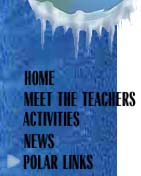
|
OceanographyThe oceanography links do not necessarily include links to all of the Arctic and Antarctic Research Programs. Many of these programs conduct oceanographic research; please browse the available links in the Polar Resources Arctic and Antarctic research programs for additional information. American Geophysical Union - Science for Everyone Earth science stories, reports, and images that are specially selected to help convey the wonder of our home planet and beyond. C.O.O.L classroom Rutgers Marine and Coastal Sciences have built a special website for students and teachers that visitors to join the scientists in the COOLroom as they explore the waters off New Jersey. Discovery Channel Online Watch the size of the ice in Antarctica increase and decrease as the month of the year changes. The Glacier Society is dedicated to the restoration and operation of the nation's largest surviving icebreaker of her kind, the USS/USCGC GLACIER. The GLACIER will serve as a living museum honoring the men and women who parcticipated in the exploration of the North and South Poles. Ice and Climate Division of the British Antarctic Survey. The aim of the research undertaken by the Ice and Climate Division is to understand the present behaviour of the ice-atmosphere-ocean system in Antarctica and its evolution in the past, and to use this knowledge to predict future behaviour. Integrated Earth Information Server of the National Science Foundation. Geosciences. Integrated Earth Information Server (IEIS) built on the infrastructure provided by the nation-wide Unidata Internet Data Distribution (IDD) network, in which parcticipating universities are establishing information servers containing a range of earth-related data. Information available includes: current electronic weather maps and bulletins; oceanographic, seismic, and other environmental information; instructional materials to complement the data. Institute of Antarctic and Southern Ocean Studies National Aeronautics and Space Administration (NASA) This home page describes some of the interesting facts and features of the Arctic and Antarctic regions and how we observe these regions using satellites. The primary science focus is on sea ice, which is ice formed in the oceans, and how we study it using RADAR or SAR imagery. National Oceanic and Atmospheric Administration (NOAA) NOAA, part of the US Department of Commerse, is charged with describing and predicting changes in the Earth's environment, and conserving and managing wisely the Nation's coastal nd marine resources to ensure sustainable economic opportunities. National Snow and Ice Data Center (NSIDC) NSIDC, located at the University of Colorado, is a data and information resource for those studying snow and ice, and their importance to the Earth system. Observers Guide to Sea Ice. Provides pictures of sea ice throughout different locations in Alaska.
Office of Polar Programs
(OPP) National Science Foundation (NSF) NSF's programs for support of
research in the Antarctic and the Arctic. |
